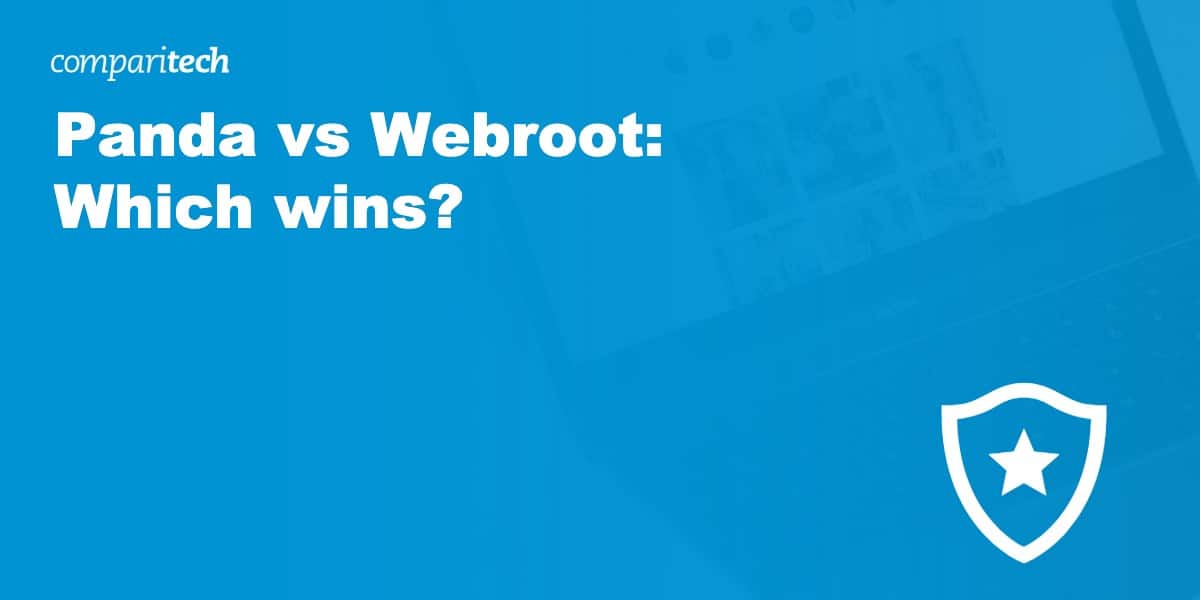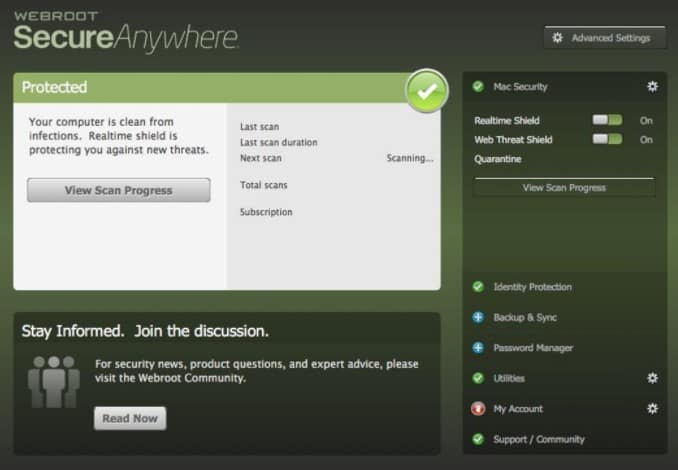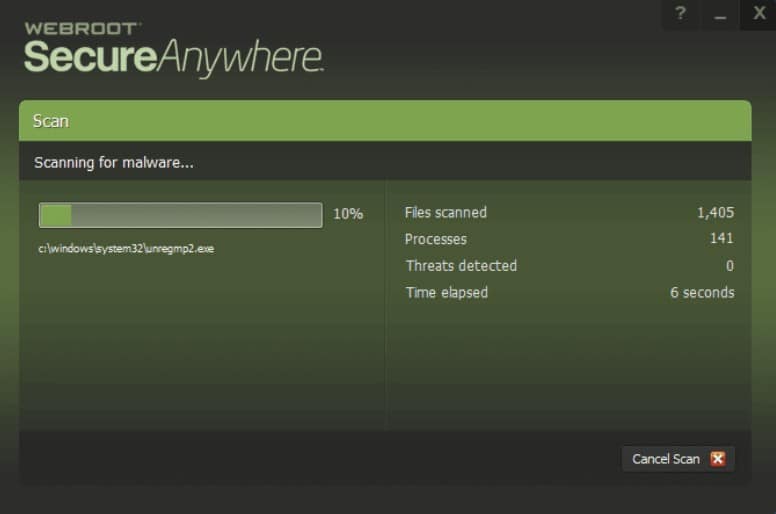It’s more important now than ever to protect your data and security. Antivirus software is a must if you want to keep your PC and files free from malware and viruses like trojans, worms, or adware. In this comparison, I run several tests to uncover which antivirus best protects your devices, Panda or Webroot.
I delve into the pros and cons of each antivirus program, pitting them head to head. Find out which program offers the best PC protection, additional security features, speed, and value for money. I’ll also review the signup process and how easy each interface is to use before delivering my final verdict.
If you don’t have the time to read the full comparison, during my tests, I found Panda to be the best option when compared with Webroot. Read on to find out all the details of the comparison and how I came to that conclusion.
Panda vs Webroot Summary
Panda
- Low system impact, cloud-based antivirus
- Premium VPN
- Parental controls
Webroot
- 25GB Cloud Storage
- Webcam protection
- Network attack protection
Below is a list of the features included in both premium antivirus suites.
| Feature | Panda | Webroot |
|---|---|---|
| Antivirus and antispyware |  |
 |
| Firewall |  |
 |
| Webcam protection |  |
 |
| Password manager |  |
 |
| Anti-phishing |  |
 |
| Ransomware protection |  |
 |
| Banking and payment protection |  |
 |
| Parental control |  |
 |
| Network attack protection |  |
 |
| Encrypted storage |  |
 (up to 25GB) (up to 25GB) |
| Automatically update apps |  |
 |
| VPN |  (premium VPN included in premium subscription) (premium VPN included in premium subscription) |
 |
| File shredder |  |
 |
| Performance optimization |  |
 |
| Identity theft protection |  |
 |
| File backup |  |
 |
BEST DEAL FOR PANDA:Save 50% on all Panda Packages and get a 30-day money-back guarantee.
BEST DEAL FOR WEBROOT:Save 40% on Webroot Antivirus and VPN for the highest levels of protection for multiple devices.
Background
Panda launched in 1990, releasing Panda Cloud Antivirus in 2005. Its scanning engine uses cloud software to isolate and block threats, including the latest zero-day malware.
Webroot secures businesses and individuals worldwide with threat intelligence and protection for endpoints and networks. Today it’s a leader in cyber resilience, offering total endpoint protection and disaster recovery for individuals and businesses of any size.
Pricing and compatibility
All antivirus providers offer a range of products at varying price points to appeal to different customers. As expected, as you go up in price, the level of protection improves, and the number of added features increases.
Many antivirus companies offer a discount in the first year to sign up new customers. Below, I’ll look at the costs for different products in the Webroot and Panda range and discuss what’s included in the price.
| Webroot Secure Anywhere Antivirus | Webroot Secure Anywhere Internet Security Plus | Webroot Secure Anywhere Internet Security Complete |
|---|---|---|
| $39.99 per year | $59.99 per year | $79.99 per year |
| Panda Essential | Panda Advanced | Panda Complete | Panda Premium |
|---|---|---|---|
| $58.99 per year | $70.99 per year | $106.99 per year | $166.99 per year |
Panda is more expensive than Webroot, with both the basic antivirus and premium packages costing a considerable amount more in comparison.
Both companies offer discounts for new customers in the first year of subscription. Webroot offers a $10 (GBP £7.25) discount on its basic antivirus, making it $29.99 (GBP £21.74) for the first year. A $15 (GBP £10.87) discount is applied to Internet Security Plus, making it $44.99 (GBP £32.62) for the first year, while Internet Security Complete is available with a $20 (GBP £14.50) first-year discount, making it $59.99 (GBP £43.50).
With the first-year discounts applied, Panda Essential is available at $41.29 (GBP £29.94), Panda Advanced costs $42.59 (GBP £30.88), Panda Complete is $53.49 (GBP £38.78), and Panda Premium is priced at $83.49 (GBP £60.54) for the first year.
If you find that the software is not right for you, Panda lets you try the first month free, and you can cancel your contract within 30 days. Webroot offers a longer-than-average 70-day money-back guarantee, which is great if you’re not happy for any reason. Both programs work with Windows, macOS, and Android devices.
Effectiveness against malware
As threats evolve and malware becomes more sophisticated, the importance of choosing the strongest antivirus defense is more critical than ever. To find out if Panda or Webroot provides the best protection for your PC, I ran a number of tests to see how they identified and dealt with malware. In addition to my own tests, I looked for further evidence from the benchmarking tests conducted by leading independent antivirus testing labs.
I wanted to conduct my own tests to check for malware threats in real-time rather than waiting until a scheduled scan was due. The live sample data is shown in the table below under ‘Live Sample’. I also downloaded some test files from The European Institute for Computer Antivirus Research (EICAR). I turned off real-time detection and ran a full system scan and a quick scan to see how well the malware was detected and quarantined. This is shown in the table under ‘EICAR Sample’.
| Test File | EICAR Sample 1 | EICAR Sample 2 | EICAR Sample 3 | EICAR Sample 4 | Live Sample 1 (Adware) | Live Sample 2 (Trojan) | Live Sample 3 (Trojan) |
|---|---|---|---|---|---|---|---|
| Panda | Blocked | Blocked | Allowed | Allowed | Blocked | Blocked | Blocked |
| Webroot | Allowed | Allowed | Allowed | Allowed | Blocked | Blocked | Blocked |
As you can see from the table above, both Panda and Webroot displayed mixed results in the virus tests I conducted on my PC. Panda blocked two of the four EICAR samples and all three of the live malware samples. Webroot allowed all four EICAR samples and blocked the three live samples.
Panda allowed all zipped EICAR files until they were unzipped. It blocked all live malware samples but allowed them up until the attempt to run them as programs (other tools I’ve tested removed the live malware samples immediately). So although Panda blocked the files, it did so in an unusual way—and much later than I would expect an antivirus suite to block or delete a potentially malicious file.
I also wanted to check how my test results compared with those generated by leading lab tests. These are independent tests that are run several times per year by AV-Comparatives. In its latest real-world protection test, AV-Comparatives found Panda blocked 99.9 percent of the 734 test malware samples. Webroot was not included in the AV-Comparatives tests.
AV-Comparatives also runs false alarm tests. These show how many times an item or webpage is incorrectly flagged as potentially dangerous and give a good indicator of how accurate the antivirus is. False alarms cause concern for no reason and can be a hindrance to the user. In March 2020, AV-Comparatives found that Panda scored a high 48 false alarms. Again, Webroot was not included in the false alarm test.
It’s difficult to verify the performance of Webroot without any recent data available from the independent labs. Panda scored better in my own tests and scored very well with AV-Comparatives, recording a 99.9 percent success rate. Panda is my winner in this section, although the number of false alarms should be noted as a potential negative.
Impact on PC performance
A large antivirus program scanning your device can cause issues with PC performance. Panda and Webroot claim to run fast scans that can be performed without interruption to the user. To determine if the claims hold up and which one has the lightest impact on performance, I captured some key numbers while running scans with the programs. The quick scan results are available in the table below.
| Test Type | Control CPU Utilization % (no scan) | Control Memory Utilization % (no scan) | Control Disk Utilization (MB/s) (no scan) | Quick Scan CPU Utilization % | Quick Scan Memory Utilization % | Quick Scan Disk Utilization (MB/s) | Quick Scan Time (seconds) |
|---|---|---|---|---|---|---|---|
| Panda | 19 | 85 | 27 | 38 | 87 | 384 | 3 |
| Webroot | 25 | 67 | 10 | 31 | 78 | 97 | 1 |
The table shows that Panda has a lighter system impact on CPU when no scan is running, while Webroot uses fewer system resources for memory and disk utilization when not running a scan. When I run a quick scan with both programs, the utilization of the CPU and memory jumps up but only slightly. Both programs show a bigger jump in the numbers recorded on disk utilization.
The following table highlights how my PC’s resources were affected by both antivirus programs during the full scan and how long a full scan took to complete. I also noted how many items were scanned in that time.
| Test Type | Full Scan Time (minutes) | Full Scan Items Scanned | Control CPU Utilization % (no scan) | Control Memory Utilization % (no scan) | Control Disk Utilization (MB/s) (no scan) | Full Scan CPU Utilization % | Full Scan Memory Utilization % | Full Scan Disk Utilization (MB/s) |
|---|---|---|---|---|---|---|---|---|
| Panda | 40 | 241385 | 19 | 85 | 27 | 46 | 80 | 284 |
| Webroot | 72 | 11938 | 25 | 67 | 10 | 95 | 63 | 721 |
The results show that Panda goes deeper into my PC and scans a substantial number of items compared with Webroot. Panda manages to scan more items in 40 minutes than Webroot processes in 72 minutes. Performance figures recorded during the full scan also show better numbers and lower overall utilization of system resources for Panda compared with Webroot. To further investigate the performance of each program, in addition to my own tests, I again looked at some independent performance tests run by AV-Comparatives. The test shows how PC performance is impacted during eight common tasks:
- Downloading files
- Browsing websites
- File Copying: first and subsequent run
- Installing and uninstalling applications
- Archiving and unarchiving
- Launching applications: first and subsequent run
Each task is given a rating ranging between very fast and slow.
In the AV-Comparatives performance test from April 2020, Panda scored very fast on all tasks but one. The task it failed to score top marks on is archiving and unarchiving, and it still received a rating of fast for this task, so we can be sure it has a very low impact on the speed of a machine.
Just like in the effectiveness tests, AV-Comparatives has not tested Webroot for performance, so I am unable to find any further data on its impact.
Features
Many antivirus programs bundle together other security features to enhance protection and make a suite stand out against competitors. This list details the main features offered with the premium versions of Panda and Webroot. Below, I will pick out a few of the most useful of these features from each provider to help you understand which may best suit your requirements.
- Antivirus and firewall
- Real-time protection
- Wi-fi protection against hackers
- Scanning of external devices for infection prevention
- Parental control for Windows: monitor and restrict device usage for your children
- Identity protection for safe online shopping and browsing
- Password generator
- Cleanup: removal of files that slow down your PC
- Premium VPN: secure, private, and unlimited internet browsing
Webroot Internet Security Complete
- Advanced threat protection for PCs and Macs
- Always-on security for your data and identity
- Protection that stops ransomware
- Real-time anti-phishing blocks harmful sites
- Firewall and network connection monitor
- Lightning-fast scans without interruption
- Secures your Android smartphones and tablets
- Protects account logins and passwords
- Eliminates traces of online activity
- 25GB of secure online storage, accessible anywhere
Here are the main highlights of each:
- VPN: A VPN is a great way to keep your internet activity private and hidden from snoopers. It can also be used to access geo-blocked content such as TV shows and movies. The premium version of Panda’s VPN offers unlimited data.
- Parental controls: A must-have feature for any parent in today’s world. This tool is included with the antivirus, which is often not the case with other providers, where you have to purchase it as a separate product.
- Password generator: Generate and store secure passwords so you don’t have to remember them and prevent the reuse of common passwords that are easy to guess.
- Secure storage – Secure cloud storage and backup for your files and photos is a very handy feature, and Webroot offers a generous 25GB of space.
- Eliminates traces of online activity – Webroot can help keep your identity private by eliminating traces of online activity that could be accessed by fraudsters.
Overall, I would give Panda the win in this section. It offers a longer list of features and a number of useful tools for the average user. This includes a VPN, password generator, and parental controls. That said, Webroot’s secure cloud storage with 25GB of space will be attractive to many users.
Signup and installation
Panda has a simple modern website that makes it easy to compare the packages on offer. Once you’ve decided which tier best suits your needs, the checkout page lets you choose how many devices you want to cover and provides the option of one or three years’ subscription. Once you’ve downloaded the software, it only takes a few minutes to set up and launch the antivirus protection.
Webroot has an intuitive layout on its website and gives users the option of comparing all antivirus products on one page or working through a tool that helps you choose the right software package for you.
Checkout is well designed, with a simple one-page layout. Webroot promotes upgrades and add-ons at the checkout stage and lets customers know that auto-renewal is automatically enabled. It’s worth turning this off if you don’t want to auto-renew your subscription.
How easy is the interface to use?
Most antivirus interfaces are fairly intuitive, but there are often differences in the user experience.
The screenshot below shows the Panda interface is designed to provide quick access to key tools, including the process monitor, firewall, parental controls, and online backup. It features a dark blue, light blue, and white color scheme. It’s handy to have all the tools in one place, but the interface is a little crowded compared to some other antivirus programs.
Webroot opts for a green and black color scheme. The main screen puts the focus on running a scan, and there are handy links on the right-hand side to quickly jump to advanced settings. These include identity protection.
The Webroot interface is minimal in contrast with Panda’s, illustrating the lack of additional features available in the Webroot suite. Overall, Panda is more aesthetically pleasing and intuitive.
Customer support
Reliable customer support is another key aspect of an antivirus brand. You may need help with the software or troubleshoot a technical issue.
Panda’s standard support is outsourced to AnyTech365, which offers help via phone and email. There’s an FAQ section and getting started guide on the Panda website. Panda also provides a premium phone support package available 24 hours per day, 365 days a year.
Webroot has solid online resources for customers to troubleshoot any issues, including FAQs, an online ticket system, plus phone support. You can contact technicians via phone during Webroot business hours. There’s a community section so you can ask other Webroot users for help.
Panda vs Webroot Conclusion
In conclusion, I have found that both Panda and Webroot have a number of pros and cons. Panda’s cloud-based scanner provided the strongest protection against malware in my own tests and the independent lab tests. Webroot is less expensive than Panda, although the discounts available with Panda do make the prices quite close for the first year of protection.
Panda and Webroot are both fast programs with a light system impact, but Panda just had the edge. Webroot’s cloud storage is a nice extra, but Panda has a more impressive additional features list, including a VPN and parental controls.
See also:
L’article Panda vs Webroot: Which wins? est apparu en premier sur Comparitech.





0 Commentaires